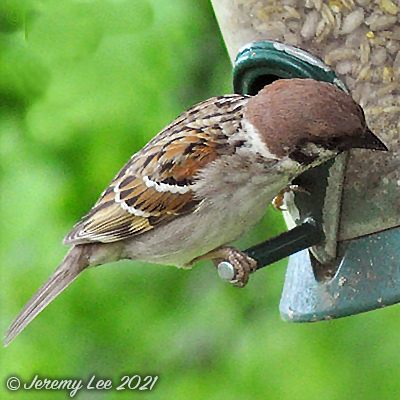
 |
|
Scientific Classifications explained » Amphibians » Ants » Aphids » Bees » Beetles » Birds » Bugs » Butterflies » Caterpillars » Damselflies » Dragonflies » Earwigs » Flies » Frog/Leafhoppers » Fungi » Galls » Grasshoppers » Harvestmen » Hoverflies » Lacewings » Ladybirds » Leaf Mines » Lichens » Mammals » Millipedes » Mosses » Moths » Sawflies » Slugs » Snails » Spiders » Trees & Shrubs » Wasps » Wild Flowers » Woodlice » Postboxes |
UK Nature > Birds > Passer montanus

Scientific Name: Passer montanus Common Name: Tree Sparrow Passer montanus, more commonly known as the Tree Sparrow, is smaller than the House Sparrow (Passer domesticus) and more active, with its tail almost permanently cocked, it has a chestnut brown head and nape (rather than grey), and white cheeks and collar with a contrasting black cheek spot. They are shyer than house sparrows in the UK and are not associated with man, although in continental Europe they often nest in buildings just like house sparrows. The UK tree sparrow population has suffered a severe decline, estimated at 93 per cent between 1970 and 2008. However, recent Breeding Bird Survey data suggests that numbers may have started to increase, albeit from a very low point. The tree sparrow is scarcer in the uplands, and the far north and west of the UK. The main populations are now found across the Midlands, southern and eastern England. Best looked for in hedgerows and woodland edges. Feeding on seeds and insects, they are present all year round in the UK. |
|

https://www.uknature.co.uk is a website dedicated to showing the immense diversity of UK nature and wildlife. Our vast range of habitats, from lowland arable to snow covered mountains, from storm-ravaged coastlines to peaceful inland freshwater lakes and rivers, from dry, sandy heaths to deciduous and coniferous forests, all these habitats contribute to the abundance of UK nature. We have wild birds in huge numbers either residing or visiting our shores (597 recorded species as at July 2013) and we must also not forget the humble back garden with its grass lawns, flower beds filled with nectar rich flowers, shrubs and trees, all designed to attract huge numbers of insects such as bees, moths, butterflies and hoverflies; and finally the small ponds which provide safe havens for frogs, toads, newts and even slow worms and grass snakes. www.uknature.co.uk is the showcase for my personal passion, photographing uknature in all its glory. I sincerely hope you all enjoy the fruits of my labours. This site and all images contained therein is © Jeremy Lee 2004 - 2025. All Rights Reserved. Site design by Jeremy Lee. Site development & IT Support by Stuart Lee. |